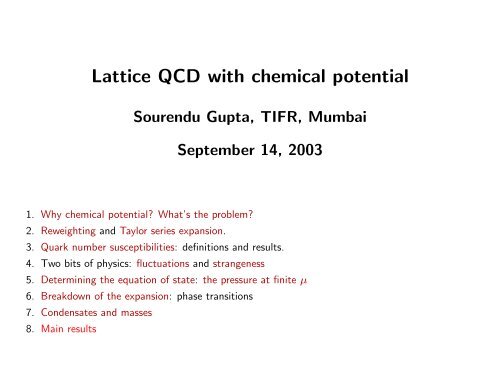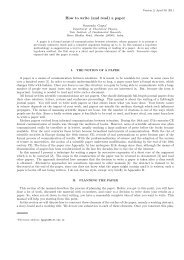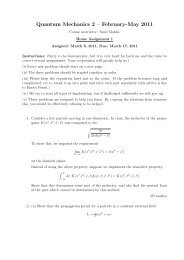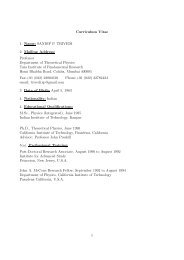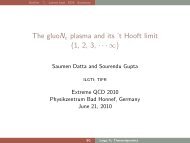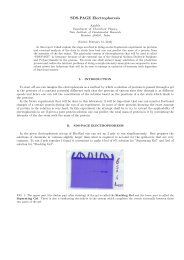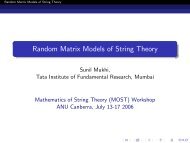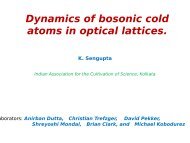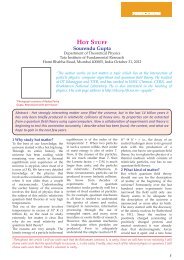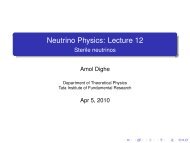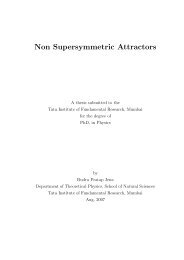Lattice QCD with chemical potential
Lattice QCD with chemical potential
Lattice QCD with chemical potential
You also want an ePaper? Increase the reach of your titles
YUMPU automatically turns print PDFs into web optimized ePapers that Google loves.
<strong>Lattice</strong> <strong>QCD</strong> <strong>with</strong> <strong>chemical</strong> <strong>potential</strong><br />
Sourendu Gupta, TIFR, Mumbai<br />
September 14, 2003<br />
1. Why <strong>chemical</strong> <strong>potential</strong>? What’s the problem?<br />
2. Reweighting and Taylor series expansion.<br />
3. Quark number susceptibilities: definitions and results.<br />
4. Two bits of physics: fluctuations and strangeness<br />
5. Determining the equation of state: the pressure at finite µ<br />
6. Breakdown of the expansion: phase transitions<br />
7. Condensates and masses<br />
8. Main results
Why <strong>chemical</strong> <strong>potential</strong>?<br />
T<br />
RHIC<br />
QGP<br />
= color<br />
superconducting<br />
crystal?<br />
gas<br />
liq<br />
CFL<br />
nuclear<br />
compact star<br />
µ<br />
Flavour symmetry: one µ for every independent conserved charge.<br />
M. G. Alford, K. Rajagopal, F. Wilczek, Phys. Lett., B 422 (1998) 247,<br />
R. Rapp, T. Schafer, E. V. Shuryak, M. Velkovsky, Phys. Rev. Lett., 81 (1998) 53.<br />
Chemical <strong>potential</strong>/S. Gupta: IMSc, 2003 to plan, Phases, Reweight, Expansion, QNS, strangeness, EOS, masses, end 2
What’s the problem?<br />
Z = e −F/T = ∫ DUe −S ∏ f det M(U, m f, µ f ) = ∫ DUe −S(T,µ)<br />
Dirac operator: M = m + i∂ µ γ µ<br />
• If there is a Q such that M † = Q † MQ, then clearly det M is real.<br />
• Q = γ 5 for µ = 0. Nothing for µ ≠ 0.<br />
• Monte Carlo simulations of Z fail.<br />
• Under CP symmetry {U} → {U ′ } such that det M(U) = [det M(U ′ )] ∗ .<br />
• Z remains real and non-negative— thermodynamics is safe.<br />
Chemical <strong>potential</strong>/S. Gupta: IMSc, 2003 to plan, Phases, Reweight, Expansion, QNS, strangeness, EOS, masses, end 3
Reweighting: what it is<br />
Do simulations at µ f = 0, re-express expectation values in terms of these—<br />
β<br />
Budapest method<br />
〈O〉 µ<br />
=<br />
〈O exp(−∆S)〉<br />
〈exp(−∆S)〉<br />
where<br />
S = S − ∑ f<br />
Tr log M f ,<br />
Glasgow method<br />
µ<br />
Reweighting done for coarse lattices (N t = 4) and N f = 4, 2 and 2+1.<br />
Chemical <strong>potential</strong>/S. Gupta: IMSc, 2003 to plan, Phases, Reweight, Expansion, QNS, strangeness, EOS, masses, end 4
Reweighting and other direct approaches<br />
• Two parameter reweighting and results.<br />
Z. Fodor and S. D. Katz, J. H. E. P., 03 (2002) 014.<br />
• Express the reweighting in terms of derivatives of Z <strong>with</strong> respect to µ.<br />
C. R. Allton et al., Phys. Rev., D 66 (2002) 074507<br />
• Simulate imaginary µ (positive det M) and do analytic continuation.<br />
M. D’Elia and M.-P. Lombardo, hep-lat/0209146<br />
P. De Forcrand and O. Philipsen, Nucl. Phys., B642 (2002) 290<br />
• Special care needed for this: find Yang-Lee zeroes directly.<br />
S, Gupta, hep-lat/0307007.<br />
• Canonical partition functions and propagator matrix.<br />
P. Crompton, P. Higgs, MILC, BI, etc<br />
Chemical <strong>potential</strong>/S. Gupta: IMSc, 2003 to plan, Phases, Reweight, Expansion, QNS, strangeness, EOS, masses, end 5
Chemical <strong>potential</strong>/S. Gupta: IMSc, 2003 to plan, Phases, Reweight, Expansion, QNS, strangeness, EOS, masses, end 6
Reweighting: lattice artifacts<br />
Chemical <strong>potential</strong> on the lattice is prescription dependent. Why? The continuum<br />
Dirac operator specifies effects of an infinitesimal time translation. On the lattice<br />
we deal <strong>with</strong> finite translations (by lattice spacing a). There are many ways of<br />
doing this which lead to the same infinitesimal transformation.<br />
This is the origin of problems <strong>with</strong> reweighting: it gives no indication of how large<br />
the lattice artifacts are.<br />
Taylor series expansion is prescription dependent beyond 2nd order at every finite<br />
lattice spacing a, but prescription independent for a → 0. With explicit Taylor<br />
expansion we can take the continuum limit.<br />
R. V. Gavai and S. Gupta, Phys. Rev. D 68 (2003) 034506.<br />
Chemical <strong>potential</strong>/S. Gupta: IMSc, 2003 to plan, Phases, Reweight, Expansion, QNS, strangeness, EOS, masses, end 7
The Taylor Expansion<br />
Since P V = −F = T log Z, the Taylor expansion of P is the same as of F !<br />
1<br />
V P (T, µ u, µ d ) = 1 V P (T, 0, 0) + ∑ f<br />
n f µ f + 1 2!<br />
where the quark number densities and susceptibilities are—<br />
∑<br />
χ fg µ f µ g + · · ·<br />
fg<br />
n f = T V<br />
χ fg = T V<br />
χ fgh··· = T V<br />
∂ log Z<br />
∂µ f<br />
∣ ∣∣∣µf<br />
=0<br />
∣<br />
∂ 2 log Z ∣∣∣µf<br />
∂µ f ∂µ g =µ g =0<br />
∂ n log Z<br />
∣<br />
∂µ f ∂µ g ∂µ h · · ·<br />
∣<br />
µf =µ g =···=0<br />
Chemical <strong>potential</strong>/S. Gupta: IMSc, 2003 to plan, Phases, Reweight, Expansion, QNS, strangeness, EOS, masses, end 8
Derivatives<br />
Derivatives of log Z can be expressed in terms of derivatives of Z. The latter can<br />
be constructed by the chain rule.<br />
Z f = ∂Z<br />
∂µ f<br />
=<br />
∫<br />
DUe −S Tr M −1<br />
f M ′ f.<br />
Note: M ′ = γ 0 and M −1 = ψψ, so Tr M −1 M ′ = ψ † ψ. Odd derivatives vanish<br />
for µ f = 0 by CP symmetry. S. Gottlieb et al., Phys. Rev. Lett., 59 (1987) 2247<br />
1 2 11<br />
111 21 3<br />
S. Gupta, Acta Phys. Pol., B 33 (2002) 4259<br />
Chemical <strong>potential</strong>/S. Gupta: IMSc, 2003 to plan, Phases, Reweight, Expansion, QNS, strangeness, EOS, masses, end 9
Quark number susceptibilities: phenomena<br />
• Fluctuations of conserved quantities in heavy-ion collisions are related to χ uu .<br />
Isospin fluctuations are related to χ 3 = χ uu − χ ud , charge fluctuations can also<br />
be constructed out of these. M. Asakawa et al., Phys. Rev. Lett., 85 (2000) 2072; S.<br />
Jeon and V. Koch, ibid., 85 (2000) 2076<br />
• Under certain conditions strangeness production rate can be related to the<br />
strange susceptibility, χ ss . R. V. Gavai et al., Phys. Rev., D 65 (2002) 054506<br />
• The pressure at finite <strong>chemical</strong> <strong>potential</strong> is essentially determined by the<br />
susceptibility. R. V. Gavai and S. Gupta, Phys. Rev. D 68 (2003) 034506.<br />
• χ 3 is the zero momentum Euclidean finite temperature vector propagator and<br />
hence closely related to a transport coefficient— the DC electrical conductivity<br />
of quark matter. S. Gupta, hep-lat/0301006.<br />
Chemical <strong>potential</strong>/S. Gupta: IMSc, 2003 to plan, Phases, Reweight, Expansion, QNS, strangeness, EOS, masses, end 10
Some notation<br />
With two degenerate flavours of quarks, in flavour space the linear susceptibilities<br />
form the matrix (<br />
χuu χ ud<br />
χ ud χ uu<br />
)<br />
Transforming to µ 0 = µ u + µ d and µ 3 = µ u − µ d , this matrix becomes<br />
(<br />
χuu + χ ud 0<br />
0 χ uu − χ ud<br />
)<br />
χ 3 = χ uu − χ ud = 〈 Tr M −1 M ′ M −1 M ′ − Tr M −1 M ′′〉<br />
χ ud =<br />
〈 (Tr<br />
M −1 M ′) 2 〉 and χ 0 = χ 3 + 2χ ud<br />
Chemical <strong>potential</strong>/S. Gupta: IMSc, 2003 to plan, Phases, Reweight, Expansion, QNS, strangeness, EOS, masses, end 11
Finding the continuum limit<br />
Main technical problem is to control the extrapolation to zero lattice spacing. For<br />
this we use two different kinds of Fermions (staggered and Naik) and perform<br />
simultaneous extrapolation <strong>with</strong> both: in the quenched theory.<br />
R. V. Gavai and S. Gupta, Phys. Rev. D 67 (2003) 034501<br />
1.8<br />
1.6<br />
/T 2<br />
χ 3<br />
1.4<br />
1.2<br />
1<br />
0.8<br />
0 0.01 0.02 0.03 0.04 0.05 0.06 0.07<br />
1/N<br />
2<br />
t<br />
Chemical <strong>potential</strong>/S. Gupta: IMSc, 2003 to plan, Phases, Reweight, Expansion, QNS, strangeness, EOS, masses, end 12
Perturbation theory<br />
1.0<br />
1<br />
0.9<br />
NL<br />
HTL<br />
0.95<br />
χ /Τ 2<br />
3<br />
0.8<br />
0.7<br />
χ uu<br />
/T 2<br />
0.9<br />
0.85<br />
∆ = 2<br />
∆ = 1<br />
∆ = 0<br />
∆ = −1<br />
∆ = −2<br />
<strong>Lattice</strong><br />
0.6<br />
1 2 3<br />
T/T c<br />
0.8<br />
1 2 3 4 5<br />
T/T c<br />
J.P. Blaizot, E. Iancu and A. Rebhan, Phys. Lett., B 523 (2001) 143<br />
A. Vuorinen, hep-ph/0212283<br />
Chemical <strong>potential</strong>/S. Gupta: IMSc, 2003 to plan, Phases, Reweight, Expansion, QNS, strangeness, EOS, masses, end 13
χ ud and χ uu<br />
1.0<br />
1<br />
χ 3 /T 2<br />
0.8<br />
0.6<br />
0.4<br />
0.2<br />
10 5 χ ud /T 2<br />
0.5<br />
0<br />
-0.5<br />
-1<br />
-1.5<br />
0<br />
0.5 1 1.5 2 2.5 3<br />
T/Tc<br />
-2<br />
0.5 1 1.5 2 2.5 3<br />
T/Tc<br />
(Note the difference in scales!)<br />
Chemical <strong>potential</strong>/S. Gupta: IMSc, 2003 to plan, Phases, Reweight, Expansion, QNS, strangeness, EOS, masses, end 14
Event to event fluctuations<br />
Each heavy-ion collision event, followed by the hadronisation, is one realisation of<br />
the whole ensemble of possible thermodynamic systems. Within a given rapidity<br />
region, the total amount of any conserved charge fluctuates from one event to<br />
another. The variance is determined by the response function of <strong>QCD</strong> matter in<br />
equilibrium.<br />
M. Asakawa et al., Phys. Rev. Lett., 85 (2000) 2072<br />
S. Jeon et al., Phys. Rev. Lett., 85 (2000) 2076<br />
D. Bower and S. Gavin, Phys. Rev., C 64 (2001) 051902<br />
From lattice computations it is seen that<br />
χ B < χ Q < χ s (T > T c )<br />
χ B > χ Q > χ s (T < T c )<br />
R. V. Gavai, S. Gupta, P. Majumdar, Phys. Rev., D 65 (2002) 054506<br />
Chemical <strong>potential</strong>/S. Gupta: IMSc, 2003 to plan, Phases, Reweight, Expansion, QNS, strangeness, EOS, masses, end 15
Strangeness production<br />
[ ]<br />
Dynamical <strong>QCD</strong> (T c )<br />
Quenched <strong>QCD</strong> (T c )<br />
RHIC Au-Au<br />
SpS S-S<br />
SpS S-Ag<br />
SpS Pb-Pb<br />
AGS Au-Au<br />
AGS Si-Au<br />
0.2 0.4 0.6 0.8 1<br />
λs<br />
J. Cleymans, J. Phys., G 28 (2002) 1575,<br />
λ s = 〈n s〉<br />
〈n u + n d 〉<br />
R. V. Gavai and S. Gupta, Phys. Rev., D 65 (2002) 094515.<br />
Chemical <strong>potential</strong>/S. Gupta: IMSc, 2003 to plan, Phases, Reweight, Expansion, QNS, strangeness, EOS, masses, end 16
The pressure<br />
P (T, µ) = −F/V = P (T, 0) + χ 3 (T )µ 2 + 1 12 χ uuuu(T )µ 4 + O ( µ 6)<br />
= P (T, 0) +<br />
(<br />
µ<br />
µ (2)<br />
∗<br />
) 2<br />
⎡<br />
⎣1 +<br />
(<br />
µ<br />
µ (4)<br />
∗<br />
) 2<br />
⎧<br />
⎨<br />
⎩ 1 + (<br />
µ<br />
µ (6)<br />
∗<br />
) ⎤<br />
2<br />
⎬<br />
+ · · ·⎫<br />
⎦ .<br />
⎭<br />
where µ (2)<br />
∗ = √ 2/χ uu , µ (4)<br />
∗ = √ 12χ uu /χ uuuu , µ (6)<br />
∗<br />
= √ 30χ uuuu /χ uuuuuu , etc.<br />
Well-behaved for µ ≪ µ ∗ . All results can be obtained in the continuum. Term by<br />
term improvement of the series is possible.<br />
Chemical <strong>potential</strong>/S. Gupta: IMSc, 2003 to plan, Phases, Reweight, Expansion, QNS, strangeness, EOS, masses, end 17
The equation of state<br />
0.5<br />
100<br />
0.4<br />
1.03<br />
10<br />
1<br />
∆P/T 4<br />
0.3<br />
0.2<br />
0.73<br />
∆ P/T 4<br />
0.1<br />
0.01<br />
1 dP<br />
T dn<br />
0.1<br />
0.44<br />
0.001<br />
0.0001<br />
0<br />
1<br />
0.15<br />
1.5 2 2.5 3<br />
T/T c<br />
0.001 0.01 0.1 1 10<br />
n/T3<br />
∆P (T ) = P (T, µ) − P (T, 0)<br />
R. V. Gavai and S. Gupta, Phys. Rev. D 68 (2003) 034506.<br />
See also<br />
Z. Fodor, S. D. Katz and K. K. Szabo, hep-lat/0208078,<br />
C. R. Allton et al., Phys. Rev., D 68 (2003) 014507.<br />
Chemical <strong>potential</strong>/S. Gupta: IMSc, 2003 to plan, Phases, Reweight, Expansion, QNS, strangeness, EOS, masses, end 18
Radius of convergence: distance to phase transitions<br />
The series expansion breaks down when a phase transition line is encountered. Use<br />
any estimate of the radius of convergence to obtain an estimate of the position of<br />
the phase transition line.<br />
4<br />
3<br />
/T<br />
*<br />
µ n<br />
2<br />
1<br />
0.95Tc<br />
2Tc<br />
0<br />
0 2 4 6 8 10<br />
n<br />
Qualitative difference between T < T c and T > T c ?<br />
Chemical <strong>potential</strong>/S. Gupta: IMSc, 2003 to plan, Phases, Reweight, Expansion, QNS, strangeness, EOS, masses, end 19
Condensates and masses<br />
Taylor expansions can also be made for expectation values of any operator. We<br />
are investigating this for<br />
1. Condensates: 〈ψψ〉 changes quadratically <strong>with</strong> µ, and the quadratic coefficient<br />
is the same for isovector and baryon <strong>chemical</strong> <strong>potential</strong>. This number is also<br />
related to λ s in strangeness production through a Maxwell relation.<br />
2. Masses: The mass splitting of charged pions at finite isovector <strong>chemical</strong><br />
<strong>potential</strong> is linear in µ, but that of the neutral pion is quadratic. This quadratic<br />
coefficient is the same as shift in pion mass at finite baryon <strong>chemical</strong> <strong>potential</strong>.<br />
O. Miyamura et al., Phys. Rev., D 66 (2002) 077502,<br />
S. Gupta, hep-lat/0202005, S. Gupta and Rajarshi Ray, in progress<br />
Chemical <strong>potential</strong>/S. Gupta: IMSc, 2003 to plan, Phases, Reweight, Expansion, QNS, strangeness, EOS, masses, end 20
Summary of Results<br />
More than one method for computing physics at finite µ. One method (Taylor<br />
series expansion) is a precision technique, allowing contact <strong>with</strong> experiments.<br />
• Computation of several high order susceptibilities may allow estimation of the<br />
critical end point by series extrapolation methods.<br />
• Fluctuations and strangeness production rate in heavy-ion collisions are related<br />
to susceptibilities.<br />
• Susceptibilities allow extension of the equation of state to finite <strong>chemical</strong><br />
<strong>potential</strong>.<br />
• Taylor expansions yield identities between behaviour of various quantities at<br />
finite isovector and baryon <strong>chemical</strong> <strong>potential</strong>.<br />
Chemical <strong>potential</strong>/S. Gupta: IMSc, 2003 to plan, Phases, Reweight, Expansion, QNS, strangeness, EOS, masses, end 21


